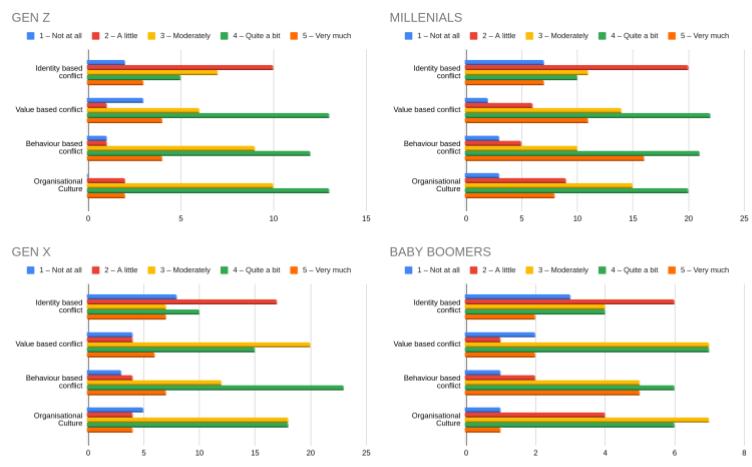17. Based on your experience please rate the following factors as potential sources of conflict between generations in the workplace. 1= not likely to cause conflict 5= very likely to cause conflict

This question asked participants to rate, based on their experience, the importance of various factors as potential sources of conflict between generations in the workplace. The rating scale ranged from 1 (not likely to cause conflict) to 5 (very likely to cause conflict). The factors considered were:
- Identity-based conflict
- Values-based conflict
- Behavior-based conflict
- Organizational culture
- Other (with space to specify)
All generations agree that differences related to identity, values, and behavior are the main sources of intergenerational conflict. Organizational culture, while important, plays a less direct role in causing conflicts but can influence their intensity. Differences in ratings among generations may reflect varied experiences and perspectives regarding conflict management in the workplace.
Gen Z (14-27 years):
Gen Z perceives identity-based conflict as the most relevant factor, followed by values and behavior. Organizational culture and other factors are seen as less critical but still significant. This reflects a sensitivity to personal and generational differences that can cause tensions.
Millennials (28-43 years):
Millennials rate identity, values, and behavior-based conflicts similarly, with slightly higher scores than Gen Z, indicating a heightened awareness of potential conflict sources. Organizational culture is viewed as important but less decisive.
Gen X (44-59 years):
Gen X assigns high scores especially to identity and values-based conflicts, recognizing behavior as an important source of tension as well. Organizational culture is perceived as a less strong but still present factor.
Baby Boomers (60-78 years):
Baby Boomers tend to rate all factors slightly lower compared to younger generations, though they acknowledge identity, values, and behavior as relevant causes of conflict. Organizational culture and other factors are considered less influential.
General Comment
This post is also available in: German Italian Polish Portuguese (Portugal)







